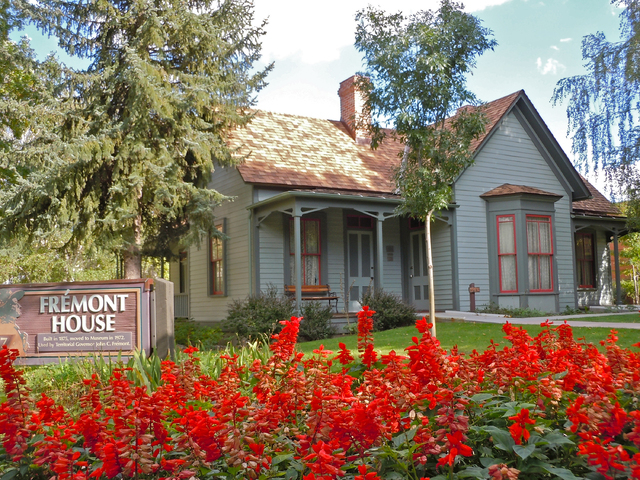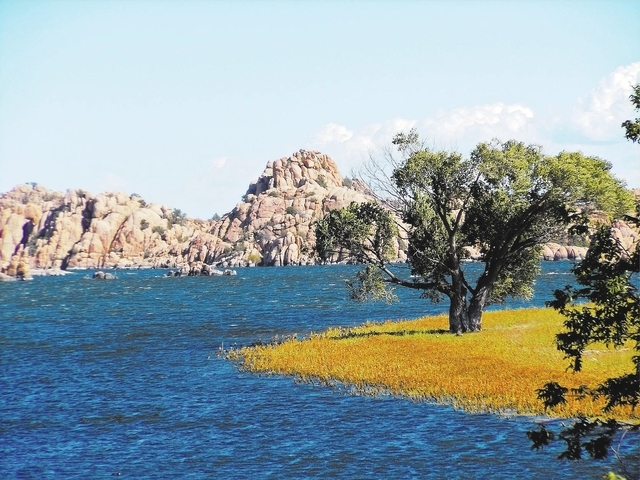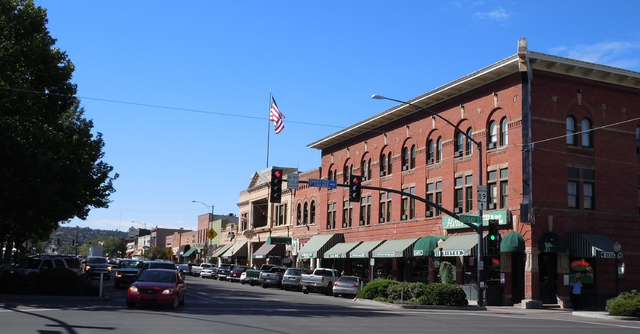Choose your own adventure in Prescott, Ariz.
Maybe hiking’s your thing.
Or perhaps you like history.
You might even prefer an afternoon at an art gallery.
Regardless, Prescott has you covered.
There’s something for everyone in this classic Arizona frontier town, with its lively mix of national forests and Old West saloons. In a two-day visit, we managed to enjoy parts of America’s largest stand of ponderosa pines, tour the 48th state’s first governor’s mansion and take in some Native American culture. We even spotted a nod to old Vegas.
Time your visit right, and you’ll have practically unlimited opportunities to blend outdoorsy adventure with history and culture.
CLOSE TO NATURE
Prescott’s best outdoors sights are spread out, ranging from the western outskirts to the mountains 15 miles east of town. But there’s a big advantage to hitting up as many attractions as possible in a day: You’ll pay a $5 daily fee to use any of the trails, picnic areas and scenic routes in the Prescott National Forest that circles town.
The best place to start your day outside is Thumb Butte, a craggy crest about 10 minutes west of downtown Prescott. Thumb Butte is the most-traveled hiking trail in the Prescott National Forest, so don’t expect solitude, especially if you go on a weekend. The earlier in the morning you hike, the lighter the trail traffic.
As one local we met on the trail said when we told him we were writing a travel piece: “Give us a glowing review, but not too glowing. We don’t want many more people coming.”
Even if you have to battle some crowds, a hike around the butte’s 1.75-mile loop trail is well worth it. The moderate climb took us past pinion pines, clumps of juniper, stands of scrub oak and shrubs of mountain mahogany. Along the way, we spotted scrub jays and woodpeckers. At the trail’s high point, we looked down into Prescott, and out toward Mingus Mountain, about 20 miles to the northeast.
Thumb Butte also pays tribute to the Prescott area’s mining past. The trail runs through what was one of the richest mining districts in the world from the late 1800s to the 1940s. Miners pulled gold, silver, copper and zinc from the ground, and the interpretive hike includes a stop at a former gold-exploration site.
There are seasonal pleasures, too: Visit shortly after a rain or in the spring, when mountain snows melt, and you’ll see small, seasonal streams burbling through washes. And from January to July, you might even spot nesting peregrine falcons.
On the advice of another local we met on Thumb Butte, we headed next to Lynx Lake Recreation Area, a pine-lined, man-made lake tucked in the Prescott National Forest in southeast Prescott. Seven hiking trails wrap around the water; we took the 2.3-mile Lynx Recreation Trail, which wound through a pine forest that cleared in spots for views of boaters on the water. Along the way, we saw two great blue heron, though we missed out on the osprey, bald eagles and deer that also thrive around the lake.
As you drive back into town, it’s worth your time to stop at the Highlands Center for Natural History, just north of Lynx Lake. Its James Learning Center is Prescott’s first building certified through the U.S. Green Building Council’s Leadership in Energy and Environmental Design (LEED) program. The solar-powered building is completely off the power grid, and it has a gift shop that stocks everything from nature-themed cookie cutters to herbal bath and beauty products. You can also wander the center’s three-mile trail system, or sign up for naturalist-led field walks. There are lectures and workshops on environmental topics, too.
For a more striking scenic view — and depending on whether winter snows have closed off access — consider a drive up and over the 7,800-foot Mingus Mountain. Its three campgrounds are closed from November to April, but if U.S. Highway 89A is open, you’ll enjoy broad views of the Verde Valley and Sedona’s red rocks. Locals will warn you about the scenic route’s hairpin twists and turns, but if you’re used to driving up to Mount Charleston’s Lee Canyon or Meadows areas, Mingus Mountain won’t scare you.
Prescott National Forest isn’t the only game in town for outdoors lovers.
The city of Prescott’s Watson Lake Park is regionally famous for its Granite Dells, dramatic formations of boulders that hug the water’s edge. The Prescott Peavine National Recreation Trail is the easiest and quickest way to see the dells. The flat, wide, dirt trail follows the lake’s eastern edge, and it takes less than a mile of walking past patches of cottonwoods and yellow wildflowers to catch glimpses of the dells. The Peavine runs four miles, and it’s faster to take it all in via bike in the right season. Prescott Outdoors rents bikes, as well as canoes and kayaks for lake exploration, from April through October.
Some of Prescott’s natural attractions may have offseasons, but you can savor its historic and cultural offerings year-round.
HISTORY FAR FROM DRY
Prescott is rich with pioneer history. Lawman Wyatt Earp passed through to pick up his brother, Virgil, on the way to Tombstone. Prescott was also the Arizona Territory’s first capital, chosen in 1863 by settlers who wanted to keep the region’s heart away from Confederate strongholds in Tucson as the Civil War raged back east. The city’s mid-1860s origins are writ large in the buildings and museums that populate its core.
We decided to get oriented with a two-hour downtown walking tour. The Prescott Chamber of Commerce gives guided tours from May to October, but in the offseason, you can take the tour yourself using a brochure with numbered stops. There were some definite highlights among the 33 listed attractions.
The Saturday morning we took our tour, we started at the hive of activity that is Courthouse Square. The bustling block earned status in 2004 as one of 12 “distinctive destinations” from the National Trust for Historic Preservation. And in 2008, the American Planning Association named the square one of 10 “great public places” in the country. The morning we visited, we saw everything from dog-training classes to yoga sessions, with a Christian music festival thrown in for good measure.
From the square, we walked north on Montezuma Street along Whiskey Row, Prescott’s famed stretch of stores, saloons, restaurants and hotels. Must-sees include The Palace, with its 1880s carved-wood bar that patrons rescued from a devastating fire in 1900, and Sam’l Hill Hardware, rebuilt after the 1900 fire with locally hewn brick.
We didn’t spend too much time on Whiskey Row because we knew we’d be coming back later to check out its busy nightlife scene. Instead, we hoofed it two blocks north to East Sheldon Street, where we found the Santa Fe, Prescott &Phoenix Railroad Depot. The cream-colored, stucco Mission Revival building, built in 1907, now houses a stock brokerage.
The stately Hassayampa Inn on East Gurley Street was on our tour as well. The hotel, built in 1927 after Prescott residents banded together to finance a first-class hotel for road-trippers, features a quiet, elegant lobby with delicate tile work and hand-painted ceiling beams and murals.
Other notable sites include the former Prescott Public Library — Arizona’s first library funded by businessman Andrew Carnegie — and Hotel Vendome, a cozy, little two-story hotel on South Cortez Street built in the 1920s for visitors with respiratory illnesses such as tuberculosis. Prescott even has its own “Nob Hill,” a row of large, 1890s-era homes crawling up East Union Street.
After we wrapped our downtown tour, we headed to the Sharlot Hall Museum on East Gurley Street to check out a Southern Nevada connection we’d heard about.
The museum is a collection of pioneer buildings ranging from a classic one-room schoolhouse to Arizona’s first governor’s “mansion” — really a relatively primitive log cabin. The museum also contains a home that belonged to a famous local explorer. The Fremont House, built in 1875, was home to John C. Fremont, namesake of downtown Las Vegas’ Fremont Street. Fremont, a military officer who discovered how to get to Las Vegas and literally put it on the map for the first time, also served as Arizona’s fifth territorial governor from 1878 to 1881. Sharlot Hall Museum officials used Fremont’s diary to help restore the interior of Fremont’s sprawling clapboard home to its period decoration.
No trip to downtown Prescott is complete without a visit to the Smoki Museum. Built in 1935 of native stone and wood and designed to look like an Indian pueblo, the museum’s collection includes clothing and ceremonial items from the Sioux, Apache and Woodland tribes. There are also baskets made by local Yavapai, Pima, Tohono and Seri tribes.
But downtown Prescott may be most famous for its rowdy nightlife. The saloons and hotels along Whiskey Row come alive after dark, as sidewalks fill up with revelers and bars become standing room only. The most popular spot, at least among the locals we asked, is Jersey Lilly Saloon, a second-floor bar above The Palace. On the fall Saturday night we visited, it took a little patience to work our way through the crowds and get a seat on the bar’s balcony — the only balcony overlooking Courthouse Square.
In coming weeks, that view of the square could get even livelier. The city of Prescott has planned its annual Christmas Parade for Dec. 7; a lighting of its Courthouse Square Christmas trees will follow. Other area attractions, including the Sharlot Hall Museum, hold holiday-themed events, exhibits and educational programs as well.
If You Go
Location: Prescott, Ariz., is about 250 miles, or 4½ hours, from Las Vegas.
Directions: Follow U.S. Highway 95 south to U.S. Highway 93, through Boulder City and toward Kingman. Pick up Interstate 40 going east in Kingman, and head south on Arizona Highway 89 to Prescott.
Lodging: Downtown Prescott: Hassayampa Inn, 122 E. Gurley St., 928-778-9434; The Hotel St. Michael, 205 W. Gurley St., 928-776-1999. Suburban Prescott: Wyndham Garden Prescott, 4499 Arizona 69, 928-777-0770; Holiday Inn Express-Prescott, 3454 Ranch Drive, 928-445-8900
Dining: Breakfast: Dinner Bell Cafe, 321 W. Gurley St., 928-445-9888. Lunch: Lynx Lake Cafe and Store, Walker Road, 928-778-0720. Dinner: The Peacock Room at Hassayampa Inn, 928-777-9563; Gurley Street Grill, 230 W. Gurley St., 928-445-3388.





















